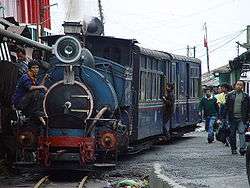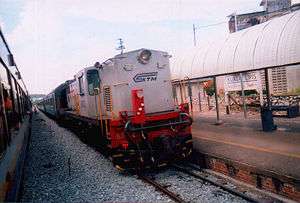Narrow gauge railways in Asia
Southeast Asia
The railways of continental Southeast Asia, including Vietnam, Cambodia, Laos, Thailand, Myanmar and Malaysia are predominantly 1,000 mm (3 ft 3 3⁄8 in) metre gauge railways. The proposed ASEAN Railway would be standard gauge or dual gauge, using both metre and standard gauge regional railway networks, linking Singapore at the southern tip of the Malay Peninsula, through Malaysia, Thailand, Laos and Vietnam to the standard gauge railway network of the People's Republic of China. Indonesia's and Philippines' railways are predominantly 1,067 mm (3 ft 6 in) (see below).
China
Some of the railway network of the People's Republic of China is 1,000 mm (3 ft 3 3⁄8 in) gauge.
Many narrow gauge railways existed in China. Metre gauge railways were popular in China in several regions before 1949. The 1,000 mm (3 ft 3 3⁄8 in) gauge Kunming-Hekou Railway (previously known as Sino-Vietnamese Railway) was built by French colonists between Vietnam and China. In Manchuria, lumber industries built narrow gauge railways into the forests, mostly of 2 ft 6 in (762 mm) gauge.
The 600 mm (1 ft 11 5⁄8 in) Gebishi Railway was built from Caoba towards Shiping and was 176 kilometres (109 mi) long. It was constructed in 1915 and the last 72 kilometres (45 mi) part was closed in 1990.
Hong Kong

In Hong Kong the Kowloon-Canton Railway was partially laid to 2 ft (610 mm) and 3 ft (914 mm) gauge during its construction in 1910 but was very soon converted to standard gauge. The Sha Tau Kok Railway was 2 ft (610 mm) gauge for much of its existence. The famous Hong Kong Tramways are 3 ft 6 in (1,067 mm) gauge, and the territory's metro, the MTR, runs on 1,432 mm (4 ft 8 3⁄8 in) except for the standard gauge KCR network it operates under a lease.
India

India has a substantial network of narrow gauge railways. The majority of these are 1,000 mm (3 ft 3 3⁄8 in) gauge or Metre gauge, totalling approximately 10,000 km of track. There are some 2 ft 6 in (762 mm) gauge railways, and a few that use 2 ft (610 mm) gauge; these are known as "narrow gauge" (as opposed to "metre gauge") lines in India.
As of 31 March 2008, of the 63,273 km railway lines in India, 9,442 km were metre gauge lines, and 2,749 km narrow gauge lines; the rest 51,082 km were broad gauge lines.[1]
All 1,000 mm (3 ft 3 3⁄8 in) (metre gauge) railways in India are being converted to 5 ft 6 in (1,676 mm) (broad gauge) under the Unigauge project.
The 2 ft (610 mm) gauge Darjeeling Himalayan Railway runs from Siliguri to Darjeeling in the state of West Bengal. The railway, along with the Nilgiri Mountain Railway (Metre Gauge) and the Kalka-Shimla Railway (2 ft 6 in (762 mm)), is listed as a Mountain Railways of India World Heritage Site by UNESCO.
Indonesia
Indonesia had large numbers of narrow gauge railways supporting industry, mainly sugar cane plantations in Java. In recent years, sugar cane production in Java has been declining and the railways are now largely closed or used for tourism.
Most of the current active railways in Indonesia use the 3 ft 6 in (1,067 mm) gauge.
Japan

Except for the high-speed Shinkansen lines and JR East Ou Main Line and Tazawako Line, all of Japan Railways Group's network is narrow gauge, built at 1,067 mm (3 ft 6 in). Some companies, such as Kintetsu, Keisei Electric Railway, Keihin Electric Express Railway, Hankyu Railway, Toei Asakusa Line, Tokyo Metro's Ginza Line and Marunouchi line, use standard gauge.
Tokyo's Keio Corporation network and the Toei Shinjuku subway line, which operate through services, use an exceptional 1,372 mm (4 ft 6 in) gauge. This gauge is also used on the Tokyo and Hakodate tramways.
Japan adopted 762 mm (2 ft 6 in) as a standard narrow gauge for minor, forestry and industrial lines. However, most of these narrow gauge lines were abandoned, and only four lines remain in operation (Kintetsu Utsube Line, Kintetsu Hachioji Line, Sangi Railway, and Kurobe Gorge Railway).
Malaysia

Malaysia's oldest railway systems are solely 1,000 mm (3 ft 3 3⁄8 in) gauge, a standard that has been adopted since the British colonial government laid down the first railway lines in 1885.
Keretapi Tanah Melayu, the main railway operator in Peninsular Malaysia, uses metre gauge for the main west and east coast intercity lines, as well as railway lines spanning Singapore, from the Johor-Singapore Causeway to the Tanjong Pagar railway station. Existing metre gauge lines are also used for KTM Komuter, the country's commuter rail service, which links Kuala Lumpur with neighbouring suburbs. However, standard gauge is used by the newer light rail operators in Kuala Lumpur city (Putra LRT, Star LRT) as well as the privately operated Express Rail Link to the airport.
In Sabah, the North Borneo Railway ("Keretapi Negeri Sabah") runs a metre gauge line from Kota Kinabalu up to Tenom in the Crocker Ranges, via Beaufort. Steam trains are also used in this route.
Middle East
Until 1932 a narrow gauge train ran from Cairo through Palestine, Lebanon, Syria, Turkey, Persia (later Iran) and Iraq. The tracks and stations are mostly tourist sites, with some sections refurbished and run as a tourist attraction. The train was notorious for being slow, and failing to go uphill.
While there were some narrow gauge lines from the coast to Beirut and Damascus, the Cairo to Turkey line was mostly standard gauge.
Now, only Jordan use narrow gauge (3 ft 5 in)1050mm.
Pakistan

Pakistan inherited 736 route kilometers of 762 mm (2 ft 6 in) narrow gauge railway lines at the time of Independence in 1947. Of this, 124 km from Jacobabad to Kashmore was converted to Broad gauge in 1956.
The remaining 612 km of narrow gauge railway lines were all closed between 1985 and 1991. They were:
- Bostan-Zhob (294 km closed in 1985)[2]
- Mari Indus-Lakki Marwat-Bannu (144 km closed in 1991)
- Lakki Marwat-Tank (74 km closed in 1991)
- Kohat-Thal (100 km closed in 1991).[3]
Now all these narrow gauge railway lines have been dismantled.
Philippines

Except for the LRT Line 1, LRT Line 2 and MRT Line 3 systems in Metro Manila, which have both been constructed to the international standard gauge, the Philippine National Railways ("PNR") uses the 3 ft 6 in (1,067 mm) track gauge. The PNR currently has only one line: from Manila to the southern Luzon city of Legazpi, but only operates commuter rail services in Metro Manila. Until the 1980s a more extensive network existed going as far north as San Fernando in La Union province.
There are also a number of industrial narrow gauge steam railways operated by the sugar cane industry. These are concentrated on the islands of Negros and Panay. The Visayas region is the main center for the sugar cane lines; some of the mills, such as La Carlotta Milling in Negros, run charter trains for tourists.
Abandoned lines exists on the islands of Cebu, abandoned in the 1950s or 1960s, Mindanao, and Panay, closed in the 1990s. Panay Railways' operated a single 3 ft 6 in (1,067 mm) rail line from Roxas City and Iloilo City until the mid-1980s.
Taiwan

Taiwan started to build up railway in the Qing dynasty using 3 ft 6 in (1,067 mm) gauge. The Japanese colonial government, which ruled from 1895 to 1945, continued using 3 ft 6 in (1,067 mm). The system is now under Taiwan Railway Administration. The new Taipei Metro and Kaohsiung MRT use standard gauge. The Taiwan High Speed Rail (THSR), which started operation in January 2007, also uses standard gauge. An isolated 2 ft 6 in (762 mm) gauge line on the east coast was regauged to 3 ft 6 in (1,067 mm) when the line was interconnected.
A 2 ft 6 in (762 mm) narrow gauge Alishan Forest Railway stretches 72 km and connects the city of Chiayi to the mountain resort of Alishan. The line serves mainly as a tourist attraction and offers breathtaking mountain views.
On 7 September 2006, Taiwanese government declared a plan to update to a standard gauge system.[4] Though, it's not the first time that this plan was proposed. In fact, some of the facilities have allowed for standard gauge conversion such as the underground tunnels constructed since the late 1980s. Many experts criticize the proposal as prohibitively expensive especially given that most lines would likely experience modest, if any, benefits of upgrading.
Thailand
While the Northern Line was originally build as 1,435 mm (4 ft 8 1⁄2 in) standard gauge, the line was regauged after 1919 and the State Railway of Thailand now operates entirely on 1,000 mm (3 ft 3 3⁄8 in) gauge, including international through services to Malaysia and Laos. However, standard gauge is used by the Bangkok Skytrain and the Bangkok Metro and the new Bangkok airport link due to be open in August 2009. In 2010, new high speed lines are to be standard gauge again.
Sri Lanka
Sri Lanka's railway network consist of 59 km of narrow gauge owned by Sri Lanka Railways currently converted to broad gauge. This line runs from Colombo Fort to Avissawella and it is known as Kalani Valley Railway (කැලණි නිම්න දුම් රිය මාර්ගය) because it runs on the sides of Kalani River. Narrow gauge locomotives are categorized as Class N & P in SL coaster.
References
- ↑ compiled and edited by Research, Reference and Training Division. (2010). India Yearbook 2010. Publications Division, Ministry of Information & Broadcasting, Govt. of India. p. 961. ISBN 81-230-1557-7.
- ↑ Zhob Valley Railway (ZVR) of Pakistan
- ↑ The International Steam
- ↑ Taiwan National News